The Mustard Seed Market is estimated to be valued at USD 813.3 billion in 2025 and is projected to reach USD 1,227.3 billion by 2035, registering a compound annual growth rate (CAGR) of 4.2% over the forecast period.
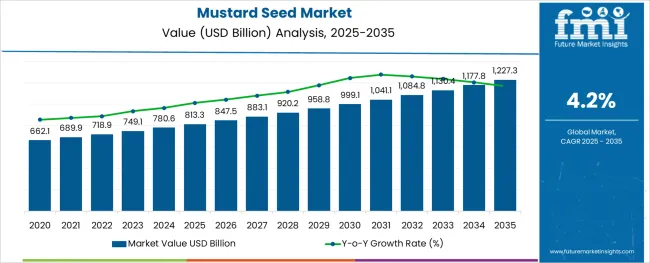
The mustard seed market is witnessing steady growth, supported by increasing demand in food processing, condiments, health supplements, and industrial applications. Rising awareness around the nutritional value and preservative properties of mustard seeds has strengthened their use across commercial kitchens and packaged food formulations.
Supportive government initiatives promoting oilseed cultivation, along with advancements in cold-pressing and processing technologies, have enabled producers to improve quality while maintaining yield. In addition, rising health-conscious consumer behavior is fueling demand for clean-label ingredients and spice extracts, positioning mustard seeds as a versatile commodity.
Shifts toward organic farming, contract farming models, and value-added mustard derivatives are expected to further drive innovation and scalability in this sector.
The market is segmented by Type, Application, and Sales Channel and region. By Type, the market is divided into White/Yellow Mustard Seeds, Black Mustard Seeds, and Sarepta Mustard Seeds. In terms of Application, the market is classified into Commercial, Industrial, and Household. Based on Sales Channel, the market is segmented into Indirect and Direct.
Regionally, the market is classified into North America, Latin America, Western Europe, Eastern Europe, Balkan & Baltic Countries, Russia & Belarus, Central Asia, East Asia, South Asia & Pacific, and the Middle East & Africa.
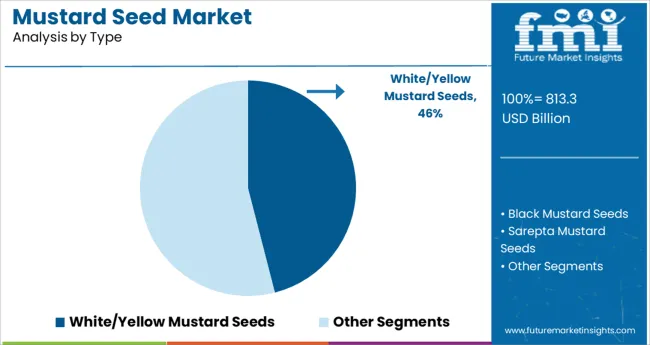
White/yellow mustard seeds are anticipated to account for 46.0% of the total market revenue by 2025, positioning them as the leading type segment. Their growth has been supported by milder flavor profiles that make them favorable for a broad range of culinary and industrial uses.
Higher oil content, quicker germination rates, and strong adaptability to temperate climates have contributed to their widespread cultivation. Additionally, their use as functional ingredients in condiments, emulsifiers, and health-based formulations is growing steadily.
Their compatibility with organic farming practices and lower allergenic potential compared to other mustard varieties has also reinforced their preference in both B2B and end-consumer markets.
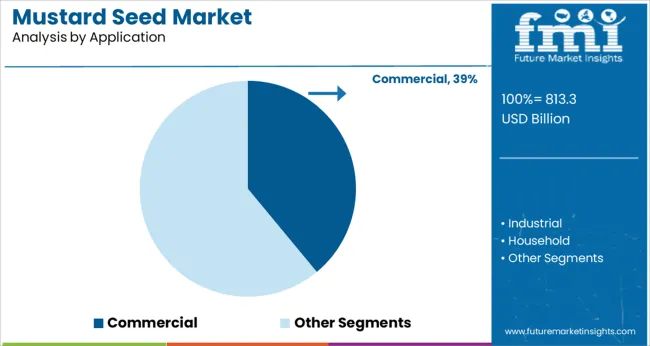
The commercial application segment is projected to contribute 39.0% of total market revenue in 2025, making it the top application segment. This share is attributed to increased utilization by food processors, spice extractors, and commercial kitchens.
Mustard seeds are extensively used in sauces, dressings, meat processing, and ready-to-eat meals owing to their pungency, preservative properties, and binding capacity. The commercial sector’s emphasis on consistent quality, scalable sourcing, and shelf-stable formulations has fueled reliance on mustard as a base ingredient.
The segment has also benefited from rising exports of mustard-based condiments and health formulations, particularly in North America and Europe, where clean-label demand is surging.
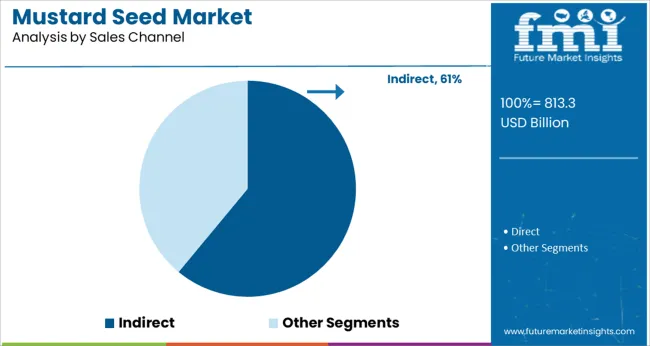
Indirect sales channels are estimated to contribute 61.0% of market revenue by 2025, making them the dominant route for mustard seed distribution. This growth is driven by the increasing role of intermediaries such as wholesalers, distributors, and ingredient aggregators who ensure volume procurement, quality control, and last-mile delivery to processors and retailers.
The preference for bulk handling, inventory control, and supplier consolidation among large buyers has strengthened indirect trade models. Digital B2B platforms are further streamlining procurement, especially in regions where farm-level aggregation and contract supply chains are being formalized.
As scalability and supply continuity become critical, indirect sales channels are expected to retain their leading position.
With the presence of a number of significant competitors, the global mustard seed market is progressively turning out diversified, which was previously fairly consolidated. Moreover, the prominent players are concentrating on expanding their commercial operations in developing nations. At the same time, most of the new mustard seed companies in the global market are preparing plans for new product development and product portfolio growth through investments and innovations.
The mustard seed market key players frequently conduct analysis of the requirement for mustard on a worldwide scale and take steps appropriately to enhance the quality of seeds produced so that they can retain their existing market demand and improve the brand value. In such a competitive market, new participants need to focus their efforts on popularizing the product and supplying it to untapped markets.
Many entrepreneurs have surfaced to make a profit out of the increasing mustard seed market opportunities in the aftermath of the pandemic food shortage and restrictions on trading agricultural items. On the other hand, over the course of this projection period, the higher expenses related to the installation and maintenance of mustard processing equipment can be a factor that might prolong the gestation period of the start-ups entering into the global mustard seed business.
Another major reason for such a higher rate of prediction for the mustard seed market growth during the forecast period is the continuous investment and innovations by food processing companies to provide better preservation solutions for all kinds of agricultural commodities.
Being a source of a lot of healthy nutrients, being great source of sterols, and for many other reasons, the demand for mustard seeds is expected to increase in the future.
Popularity of mustard seed is growing as it is nearly 40 different mustard plant species are found. In addition to this, mustard seed are available in diversified forms--black, brown and white mustard seeds, which is likely to boost the demand for mustard seeds.
Another key factor that upkeep the growth momentum of mustard seed market is its multipurpose usage as an edible plant. Almost every part of mustard plant is edible, be it seeds, leaves or flowers.
Mustard seeds being full of rich nutrients and their leaves being rich in Vitamin A, Vitamin C, and Vitamin K. These are also rich in fibre, selenium, magnesium, and manganese, which is likely to keep the popularity quo high.
Several studies have found that mustard seeds are also effective in preventing cancer. The mustard seeds also exhibit anti-inflammatory and anti-bacterial properties.
The mustard seeds are also a rich source of isothiocyanates and phenol compounds, because of which they are extremely beneficial for the body.
Previously, the CAGR for the mustard seed market was 3.6%. But with the increasing applications of the mustard seed, the anticipated CAGR for the forecast period, which stands at 4.2% highlights the fact that there is an increase in the consumption of mustard seeds and this is only expected to increase further.
Owing to a number of health benefits offered by mustard seeds, the oils made up of mustard seeds are being used in cooking instead of various other kinds of oil like sunflower oil, sesame oil etc. This is expected to increase the demand for mustard seeds.
Mustard seeds are rich source of various kinds of Vitamin B like niacin, thiamine, riboflavin etc., which are crucial for the effective functioning of Nervous System, and for maintaining a healthy metabolism as well. These benefits offered are expected to increase the demand for mustard seeds.
Mustard seeds are effective for arthritis treatment as well. Being a rich source of Omega 3 fatty acids, selenium, and magnesium, the oils made from mustard seeds are effective in treating arthritis. This is expected to increase the sales of mustard seeds.
As a method of precaution, health specialists advice people to consume mustard seeds on a regular basis. Muster seeds are rich in myrosinase and glucosinolates, which prevent the growth of cancer cells. This is anticipated t further increase the sales of mustard seeds.
Apart from high magnesium and selenium, mustard seeds are also a source of Vitamin A, Vitamin B, beta-carotene and omega 3 fatty acids. These nutrients are effective for handling asthama. This particular application is expected to increase the sales of mustard seeds.
Mustard seeds are also useful for maintaining a sound cardiovascular health. It is effective for maintaining a sound cardiovascular health, and is specifically known for reducing the bad cholesterol levels in the blood. This is expected to increase the adoption of mustard seeds.
Mustard seeds are also consumed for maintaining a strong bone health and strong teeth as well. The presence of selenium in mustard seeds ensures that the bones and teeth remain. The presence of selenium also ensures healthy nails and hair.
This is expected to increase the mustard seed market share.
The anti-inflammatory properties of mustard seeds also prevent the growth of acne. They are effective in hydrating our skin and removing the impurities from our skin. Because of this, the mustard seed market share is anticipated to increase in the coming times.
Additionally, because of the presence of Vitamin A, Vitamin C and Vitamin K, the mustard seeds slow down the ageing process of a person. Even this is anticipated to increase the market for mustard seeds.
It is important to note that there should be a regulated consumption of mustard seeds. Consuming them beyond certain limit may lead to diarrhoea, and gut inflammation.
Moreover, uncooked mustard seeds contain goitrogens. These interfere with the smooth functioning of thyroid glands, which are useful for the smooth metabolism process, which might lead to thyroid related problems. So, it is advisable to consult a health specialist before consuming mustard seeds.

North America, which currently has a market share of 24.6% is expected to show a decent growth during the forecast period.
People in North America are well informed about leading a healthy lifestyle, and are taking proactive steps as well to lead such a lifestyle. Consequently, lot of people has replaced other forms of edible oil with mustard oil. Moreover, people in this region are aware also aware of the importance of a healthy cardiovascular health. This is also seen as a major factor for the anticipated increase in the market share of mustard seeds during the forecast period.
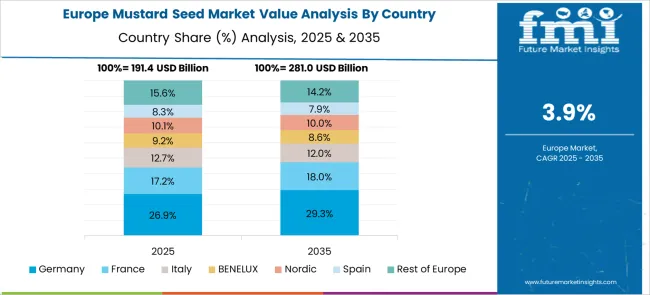
Europe, which currently has a market share of 29.7%, is expected to show a good growth rate during the forecast period.
Apart from the health benefits offered by mustard seeds, people in this region are aware of other benefits of these seeds as well. As mustard oil is highly beneficial for a glowing skin, people in this region make use of mustard oil for skin as well, apart from consumption.
Moreover, people in Europe as well are health conscious, because of which the market size of mustard seed is expected to increase in the region.
How is the Start Up Ecosystem in the Mustard Seed Market?
The mustard seeds are important for a strong body. Having so much to offer, the start up ecosystem in the mustard seed market is seeing a lot happening.
SunImpex, a Dubai based agro products start up, which was launched in 2013, was exhibiting in GULF FOOD 2024. GULF FOOD is a great platform for food producing companies to discover new trends and discover new trends. The product lines in SunImpex had been multiplying, and taking this reason into consideration, SunImpex decided to participate in the exhibition.
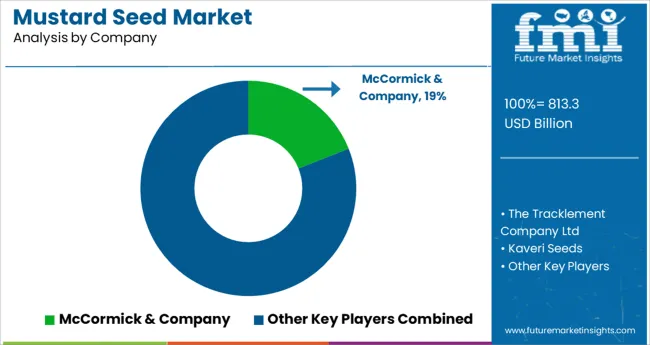
Some of the key market players in the mustard seed market are: McCormick & Company, Inc., Sakai Spice (Canada) Corp, Megha Corporation, Organic Products India, Sun Impex., The Tracklement Company Ltd, Kaveri Seeds.
With the Russia-Ukraine war taking place, farmers across the world fear that the prices of mustard seeds might increase in the future, which might also affect the demand of the mustard seed market.
| Report Attribute | Details |
|---|---|
| Growth Rate | CAGR of 4.2% from 2025 to 2035 |
| Base Year for Estimation | 2024 |
| Historical Data | 2020 to 2024 |
| Forecast Period | 2025 to 2035 |
| Quantitative Units | Revenue in million and CAGR from 2025 to 2035 |
| Report Coverage | Revenue Forecast, Volume Forecast, Company Ranking, Competitive Landscape, Growth Factors, Trends and Pricing Analysis |
| Segments Covered | Type, Application, Sales Channel, Region |
| Regions Covered |
North America; Latin America; Europe; East Asia; South Asia; Oceania; Middle East and Africa |
| Key Countries Profiled | USA, Canada, Brazil, Argentina, Germany, UK, France, Spain, Italy, Nordics, BENELUX, Australia & New Zealand, China, India, ASEAN, GCC, South Africa |
| Key Companies Profiled | McCormick & Company, Inc.; Sakai Spice (Canada) Corp; Megha Corporation; Organic Products India; Sun Impex.; The Tracklement Company Ltd; Kaveri Seeds. |
| Customization | Available Upon Request |
The global mustard seed market is estimated to be valued at USD 813.3 billion in 2025.
It is projected to reach USD 1,227.3 billion by 2035.
The market is expected to grow at a 4.2% CAGR between 2025 and 2035.
The key product types are white/yellow mustard seeds, black mustard seeds and sarepta mustard seeds.
commercial segment is expected to dominate with a 39.0% industry share in 2025.






Full Research Suite comprises of:
Market outlook & trends analysis
Interviews & case studies
Strategic recommendations
Vendor profiles & capabilities analysis
5-year forecasts
8 regions and 60+ country-level data splits
Market segment data splits
12 months of continuous data updates
DELIVERED AS:
PDF EXCEL ONLINE
Seed Paper Bag Market Size and Share Forecast Outlook 2025 to 2035
Seed Processing Equipment Market Size and Share Forecast Outlook 2025 to 2035
Seed Treatment Materials Market Size and Share Forecast Outlook 2025 to 2035
Seed Biostimulants Market Size and Share Forecast Outlook 2025 to 2035
Seed Health Market Size and Share Forecast Outlook 2025 to 2035
Seed Additives Market Analysis - Size and Share Forecast Outlook 2025 to 2035
Seed Coating Material Market Analysis - Size, Share, and Forecast 2025 to 2035
Seed Packaging Market Analysis – Growth & Forecast 2025 to 2035
Seed Binders Market Analysis - Size, Share & Forecast 2025 to 2035
Market Share Breakdown of Seed Cracker Manufacturers
Seed Polymer Market
Seed Testing Services Market Growth – Trends & Forecast 2018-2028
Teaseed Cake Market – Trends & Forecast 2025 to 2035
The Linseed Oil Market is Analysis by Nature, Product Type, Application, and Region from 2025 to 2035
Rapeseed Protein Market Size and Share Forecast Outlook 2025 to 2035
Flaxseed Gum Market Size and Share Forecast Outlook 2025 to 2035
Rapeseed Oil Market Size and Share Forecast Outlook 2025 to 2035
Analysis and Growth Projections for Hempseed Milk Business
Rapeseed Meal Market Analysis by Type, Application, Nature, and Region Through 2035
Assessing Rapeseed Protein Market Share & Industry Trends

Thank you!
You will receive an email from our Business Development Manager. Please be sure to check your SPAM/JUNK folder too.
Chat With
MaRIA